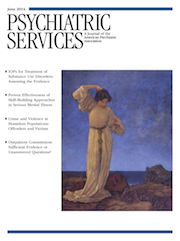Relationship of Community Integration of Persons With Severe Mental Illness and Mental Health Service Intensity
Abstract
Objective
Community integration is integral to recovery for individuals with severe mental illness. This study explored the integration of individuals with severe mental illness into mental health and non–mental health communities and associations with mental health service intensity.
Methods
Thirty-three ethnically diverse participants with severe mental illness were categorized in high-intensity (N=18) or low-intensity (N=15) mental health service groups. Community integration was assessed with measures of involvement in community activities, social capital resources, social support, social network maps, and subjective integration.
Results
Although participants rated themselves as being more integrated into the mental health community, their social networks and social capital were primarily derived from the non–mental health community. The high-intensity group had a higher proportion of members from the mental health community in their networks and had less overall social capital resources than the low-intensity group.
Conclusions
The findings suggest opportunities and possible incongruities in the experience of community integration.



